Después de ver el contexto histórico -muy por encima, ahora veamos quién es Mandela.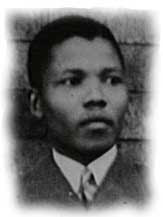 Nelson Rolihlahla Mandela nace el 18 de julio de 1918 en el seno de la tribu Thembu de la etnia Xhosa en la pequeña aldea de Mvezo. Su bisabuelo paterno, Ngubengcuka, gobernaba como Inkosi Enkhulu, o rey, del pueblo Thembu pero los descendientes de su rama de la familia real no tenían derecho a la sucesión del trono.
Nelson Rolihlahla Mandela nace el 18 de julio de 1918 en el seno de la tribu Thembu de la etnia Xhosa en la pequeña aldea de Mvezo. Su bisabuelo paterno, Ngubengcuka, gobernaba como Inkosi Enkhulu, o rey, del pueblo Thembu pero los descendientes de su rama de la familia real no tenían derecho a la sucesión del trono.
Su nombre de pila "Rolihlahla" significa "arrancar una rama de un árbol", o también "agitador".
(Nelson Rolihlahla Mandela was born on 18 July 1918 in Mvezo, a small village of the Thembu tribe of the Xhosa nation. His patrilineal great-grandfather, Ngubengcuka , ruled as the Inkosi Enkhulu, or king, of the Thembu people but the descendants of his branch of the royal family were not eligible to succeed to the Thembu throne. His given name Rolihlahla means "to pull a branch of a tree", or "troublemaker" also.)
Seguir leyendo...1927 – 1940: Cuando Mandela contaba nueve años su padre murió de tuberculosis y el regente, Jongintaba, se convirtió en su protector. Rolihlahla Mandela fue el primer miembro de su familia en ir al colegio – un colegio de misioneros de Wesleyan situado cerca del palacio del regente. Allí su maestra, la señorita Mdingane le puso el nombre inglés de "Nelson".
Siguiendo la tradición Thembu, fue inciado a la edad de dieciséis años y siguió los cursos del internado Clarkebury y obtuvo su certificado de estudios en dos años, en vez de los tres habituales. Destinado a heredar el puesto de su padre como consejero privado del regente, en 1937 es enviado a la escuela universitaria Wesleyan en Fort Beaufort como la mayoría de los hijos de la realeza Thembu.
(1927 – 1940: When Mandela was nine, his father died of tuberculosis, and the regent, Jongintaba, became his guardian. Rolihlahla Mandela became the first member of his family to attend a school, a Wesleyan mission school located next to the palace of the regent. There his teacher Miss Mdingane gave him the English name "Nelson".
Following Thembu custom, he was initiated at age sixteen, and attended Clarkebury Boarding Institute and completed his Junior Certificate in two years, instead of the usual three. Designated to inherit his father's position as a privy councillor, in 1937 Mandela moved to Healdtown, the Wesleyan college in Fort Beaufort which most Thembu royalty attended.)
 1942 – 1963: en 1942 se unió al Congreso Nacional Africano (CNA) que tenía un enfoque no violento para conseguir cambios en las leyes del apartheid. Empezó organizando protestas contra las políticas segregacionistas. En 1956, con otros 156 miembros fue procesado por traición. Después de cinco años de litigio se les absolvió. Mandela pronto se dio cuenta de que las protestas no violentas no funcionarían y se volvió hacia el sabotaje, formando el Umkhonto we Sizwe (MK) (La lanza de la nación) para actuar como el brazo militar del CNA. Seguro de que sus actuaciones le llevarían a ser arrestado de nuevo, se escondió. Sin embargo siguió arreglándoselas para organizar ataques con el MK. Al poco tiempo era el hombre más buscado de Sudáfrica; la policía lo apodó "la pimpinela negra" porque siempre escapaba.
1942 – 1963: en 1942 se unió al Congreso Nacional Africano (CNA) que tenía un enfoque no violento para conseguir cambios en las leyes del apartheid. Empezó organizando protestas contra las políticas segregacionistas. En 1956, con otros 156 miembros fue procesado por traición. Después de cinco años de litigio se les absolvió. Mandela pronto se dio cuenta de que las protestas no violentas no funcionarían y se volvió hacia el sabotaje, formando el Umkhonto we Sizwe (MK) (La lanza de la nación) para actuar como el brazo militar del CNA. Seguro de que sus actuaciones le llevarían a ser arrestado de nuevo, se escondió. Sin embargo siguió arreglándoselas para organizar ataques con el MK. Al poco tiempo era el hombre más buscado de Sudáfrica; la policía lo apodó "la pimpinela negra" porque siempre escapaba.
(In 1942, Mandela joined the African National Congress (ANC) which had a non-violent approach to seeking change to the apartheid laws. He began organising protests against apartheid policies. In 1956, he and 156 other members were brought to the court on charges of treason. After a trial lasting five years, all were found not guilty. Mandela soon realised that non-violent protests would not work, and turned to sabotage, forming Umkhonto we Sizwe (MK) (Spear of the Nation) to act as the military section of the ANC. Certain that all he had done would lead him to be arrested again, he went into hiding.
Yet, he still managed to organise attacks by MK. Before long he was the most wanted man in South Africa, with the police calling him the 'Black Pimpernel' because he always eluded capture.)
Sin embargo acabó siendo arrestado en 1962 y sentenciado a 5 años de trabajos forzados. Cuando mucho líderes del CNA y del MK fueron arrestados por complotar para derribar el gobierno por la violencia, Nelson Mandela también fue llevado a juicio con ellos, y fue uno de los 8 acusados que fueron sentenciados a la cárcel de por vida. Tenía 45 años.
(Nevertheless he was eventually arrested in 1962 and sentenced to five years' imprisonment with hard labour. When many leaders of the ANC and the MK were arrested for plotting to overthrow the government by violence, Nelson Mandela was also brought to stand trial with them, and he was one of eight accused that were sentenced to life imprisonment. He was forty five years old.)
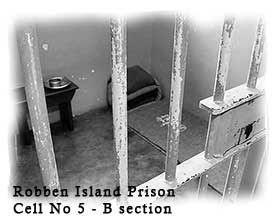 Fue enviado a la cárcel en la isla Robben. Su esposa sólo podía visitarlo durante media hora cada 6 meses. No se le permitió ver a sus hijos durante 12 años.
Fue enviado a la cárcel en la isla Robben. Su esposa sólo podía visitarlo durante media hora cada 6 meses. No se le permitió ver a sus hijos durante 12 años.
Pero Nelson no se rindió. Dirigía a otros presos para cantar canciones de libertad. De ese modo no dejaba que la cárcel lo controlara.
(He was sent to prison on Robben. His wife could visit him for just half an hour every six months. He was not allowed to see his children for 12 years.
But Nelson did not give in. He led the other prisoners in singing songs for freedom. In this way he did not let the prison control him.)

En los años 70 la resistencia contra el apartheid aumenta. La organización de las iglesias y de los trabajadores crece. Algunos blancos se unen a los negros en las manifestaciones. La Organización de estudiantes Sudafricanos sólo para negros ayuda a unir a los estudiantes bajo el liderato de Steve Biko y su movimiento por la conciencia negra.
(1970s: Resistance to apartheid increases. Organizing by churches and workers increases. Whites join blacks in the demonstrations. The all-black South African Students Organization, under the leadership of Steve Biko, helps unify students through the Black Consciousness movement.)
 El 16 de junio de 1976 la gente de Soweto se sublevó y manifestó en contra de la discriminación y la enseñanza en afrikáans, el idioma de los blancos descendientes de los holandeses. La policía reaccionó abriendo fuego. 575 personas murieron y miles fueron heridas y arrestadas. Steve Biko fue apaleado y se le dejó morir en la cárcel a consecuencia de sus heridas.
El 16 de junio de 1976 la gente de Soweto se sublevó y manifestó en contra de la discriminación y la enseñanza en afrikáans, el idioma de los blancos descendientes de los holandeses. La policía reaccionó abriendo fuego. 575 personas murieron y miles fueron heridas y arrestadas. Steve Biko fue apaleado y se le dejó morir en la cárcel a consecuencia de sus heridas.
(June 16,1976: The Soweto uprising: People in Soweto riot and demonstrate against discrimination and instruction in Afrikaans, the language of whites descended from the Dutch. The police react with gunfire. 575 people are killed and thousands are injured and arrested. Steven Biko is beaten and left in jail to die from his injuries.)
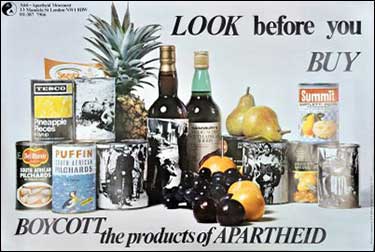
En los años 80, países de todo el mundo lanzan una campaña internacional para boicotear los productos sudafricanos hasta el punto que hacia finales de la década algunas de las leyes segregacionistas – la Ley de Servicios Públicos Separados por ejemplo – son revocadas.
(1980s: Countries around the world launch an international campaign to boycott the import of South African products. As a result, by the late '80s some of the segregationist laws – the Preservation of Separate Amenities Act, for example – are repealed.)

Cuando Frederik Willem de Klerk, en septiembre de 1989, asume la presidencia, aboga por una Sudáfrica no racista y por entablar negociaciones sobre el futuro del país. El 2 de febrero de 1990 legaliza el CNA y todas las demás organizaciones políticas y anuncia la liberación de Nelson Mandela. Acabó con el apartheid y abrió el camino para redactar una nueva constitución para el país basada en el principio de "una persona, un voto" y el afianzamiento de los derechos humanos fundamentales.
(When Frederik Willem de Klerk was elected State President in September 1989, he called for a nonracist South Africa and for negotiations about the country's future. On 2 February 1990 he lifted the ban on the ANC and all other political organisations and announced the release of Nelson Mandela. He brought apartheid to an end and opened the way for the drafting of a new constitution for the country based on the principle of "one person, one vote" and the entrenchment of basic human rights.)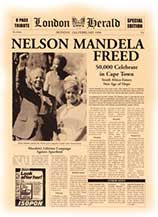 Finalmente el día 11 de febrero de 1990 Mandela sale libre tras 27 años de encierro.
Finalmente el día 11 de febrero de 1990 Mandela sale libre tras 27 años de encierro.
Poco después todo el mundo, blancos y negros, en ciudades y pueblos pudieron votar y así el 27 de abril de 1994 convierte a Nelson Mandela en su presidente y a De Klerk su vice presidente.
(Finally, on February 11, 1990, Mandela was released from prison after 27 years.
Soon after, all people, white and black, in cities and villages, were allowed to vote, and they made Nelson Mandela their president and De Klerk vice-president.)
Hoy más de 40 millones de personas de muy distintas procedencias viven en Sudáfica. Por eso se la llama a veces la "nación arco iris".
"Sudáfrica está empezando a alejarse de los malos años del apartheid. Los sudafricanos, blancos y negros, están participando en acontecimientos deportivos – algo que habría sido imposible bajo el apartheid."
(Today, there are over 40 million people living in South Africa from lots of different backgrounds. "That is why it is sometimes known as the "Rainbow Nation".
"South Africa is beginning to move away from the bad years of apartheid. South African people, both black and white, are taking part in sporting events — something that would have been impossible under apartheid.")

Como dice Brian Malan en su artículo Invictus: una victoria que constuyó una nación en The Telegraph:
"Cuando Mandela se convirtió en el fan número uno de los Sprinbock, aprendiéndose los nombres de los jugadores, visitándoles en sus sesiones de entrenamiento y apremiándoles para ganar la Copa Mundial de 1995 para una nación que aún existía sólo en el papel... para muchos negros, ese comportamiento bordeaba la traición racial, pero el anciano estaba jugando un juego astuto. Para los afrikáners el rugby es sagrado y para nosotros su interés en el juego era inexplicable pero tremendamente entrañable, sobre todo cuando vino a la final de la Copa del Mundo llevando los colores de los Sprinbock. Se ha escrito mucho sobre la valentía política y el espíritu de generosidad de Mandela, pero era más que eso: parecía estar demostrándonos que nos quería, a pesar de todo, y de repente parecía mezquino no responder de la misma manera."
(As puts it in his article Invictus: victory that built a nation in the Telegraph: "When Mandela transformed himself into the Springboks’ number one fan, memorising the names of the players, visiting their practice sessions and urging them to win the 1995 World Cup for a nation that existed only on paper...For many blacks, Mandela’s behaviour bordered on race betrayal, but the old man was playing a canny game. Afrikaners hold rugby sacred, and we found his interest in the sport inexplicable but hugely endearing, especially when he came to the World Cup final wearing Springbok colours. Screeds have been written about Mandela’s political courage and generosity of spirit, but it was more than that: he seemed to be showing that he loved us, in spite of everything, and it suddenly seemed churlish not to respond in kind.")
"If there are dreams about a beautiful South Africa, there are also roads that lead to their goal. Two of these roads could be named Goodness and Forgiveness." Nelson Mandela.
(Si hay sueños acerca de una bella Sudáfrica, también hay caminos que llevan a su consecución. Dos de esos caminos podrían llamarse Bondad y Perdón.")
"Peace does not fare well where poverty and deprivation reign. It does not flourish where there is ignorance and a lack of education and information. Repression, injustice and exploitation are inimical with peace. Peace is gravely threatened by inter-group fear and envy and by the unleashing of unrealistic expectations. Racial, class and religious intolerance and prejudice are its mortal enemies." F.W. de Klerk.
(La paz no es posible donde reina la pobreza y la necesidad. No florece donde hay ignorancia y falta de educación e información. La represión, la injusticia y la explotación son contrarias a la paz. La paz se ve gravemente amenazada por el miedo entre grupos, la envidia y el desatar esperanzas poco realistas. La intolerancia racial, de clase o religiosa y los prejuicios son sus enemigos mortales.")
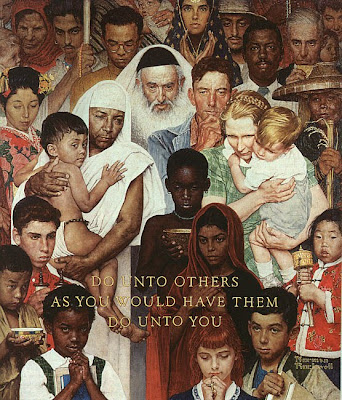 "Haz a los demás lo que te gustaría que te hicieran a ti."
"Haz a los demás lo que te gustaría que te hicieran a ti."Y como ayer fue el 126 aniversario del nacimiento de Norman Rockwell (uno de mis ilustradores favoritos), os dejo este cuadro que pintó en 1961, "Do Unto Others", con el lema al que si fuéramos más fieles, quizá no habría tantas injusticias a nuestro alrededor.
Fuente:
A tribute to Madiba
BBC, Mandela en tres actos
Nelson Mandela Foundation




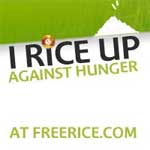









No hay comentarios :
Publicar un comentario